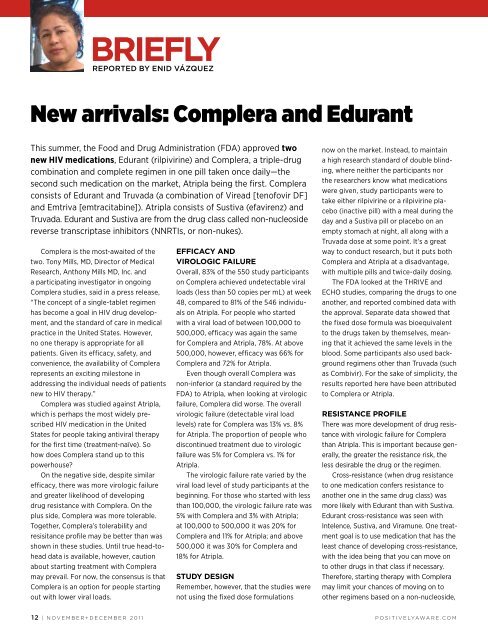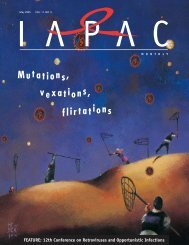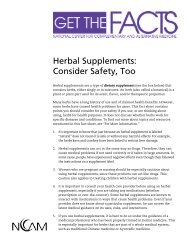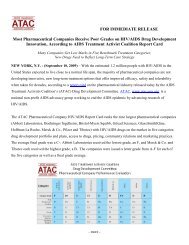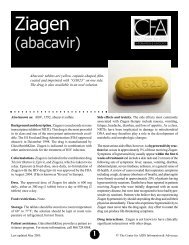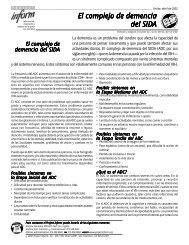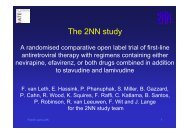Briefly - CD8 T cells - The Body
Briefly - CD8 T cells - The Body
Briefly - CD8 T cells - The Body
Create successful ePaper yourself
Turn your PDF publications into a flip-book with our unique Google optimized e-Paper software.
Riefly<br />
rePorTeD By enID VÁZqueZ<br />
New arrivals: Complera and Edurant<br />
This summer, the Food and Drug Administration (FDA) approved two<br />
new HIV medications, Edurant (rilpivirine) and Complera, a triple-drug<br />
combination and complete regimen in one pill taken once daily—the<br />
second such medication on the market, Atripla being the first. Complera<br />
consists of Edurant and Truvada (a combination of Viread [tenofovir DF]<br />
and Emtriva [emtracitabine]). Atripla consists of Sustiva (efavirenz) and<br />
Truvada. Edurant and Sustiva are from the drug class called non-nucleoside<br />
reverse transcriptase inhibitors (NNRTIs, or non-nukes).<br />
Complera is the most-awaited of the<br />
two. Tony Mills, MD, Director of Medical<br />
Research, Anthony Mills MD, Inc. and<br />
a participating investigator in ongoing<br />
Complera studies, said in a press release,<br />
“<strong>The</strong> concept of a single-tablet regimen<br />
has become a goal in HIV drug development,<br />
and the standard of care in medical<br />
practice in the United States. However,<br />
no one therapy is appropriate for all<br />
patients. Given its efficacy, safety, and<br />
convenience, the availability of Complera<br />
represents an exciting milestone in<br />
addressing the individual needs of patients<br />
new to HIV therapy.”<br />
Complera was studied against Atripla,<br />
which is perhaps the most widely prescribed<br />
HIV medication in the United<br />
States for people taking antiviral therapy<br />
for the first time (treatment-naïve). So<br />
how does Complera stand up to this<br />
powerhouse?<br />
On the negative side, despite similar<br />
efficacy, there was more virologic failure<br />
and greater likelihood of developing<br />
drug resistance with Complera. On the<br />
plus side, Complera was more tolerable.<br />
Together, Complera’s tolerability and<br />
resisitance profile may be better than was<br />
shown in these studies. Until true head-tohead<br />
data is available, however, caution<br />
about starting treatment with Complera<br />
may prevail. For now, the consensus is that<br />
Complera is an option for people starting<br />
out with lower viral loads.<br />
efficacy anD<br />
ViRologic failuRe<br />
Overall, 83% of the 550 study participants<br />
on Complera achieved undetectable viral<br />
loads (less than 50 copies per mL) at week<br />
48, compared to 81% of the 546 individuals<br />
on Atripla. For people who started<br />
with a viral load of between 100,000 to<br />
500,000, efficacy was again the same<br />
for Complera and Atripla, 78%. At above<br />
500,000, however, efficacy was 66% for<br />
Complera and 72% for Atripla.<br />
Even though overall Complera was<br />
non-inferior (a standard required by the<br />
FDA) to Atripla, when looking at virologic<br />
failure, Complera did worse. <strong>The</strong> overall<br />
virologic failure (detectable viral load<br />
levels) rate for Complera was 13% vs. 8%<br />
for Atripla. <strong>The</strong> proportion of people who<br />
discontinued treatment due to virologic<br />
failure was 5% for Complera vs. 1% for<br />
Atripla.<br />
<strong>The</strong> virologic failure rate varied by the<br />
viral load level of study participants at the<br />
beginning. For those who started with less<br />
than 100,000, the virologic failure rate was<br />
5% with Complera and 3% with Atripla;<br />
at 100,000 to 500,000 it was 20% for<br />
Complera and 11% for Atripla; and above<br />
500,000 it was 30% for Complera and<br />
18% for Atripla.<br />
stuDy Design<br />
Remember, however, that the studies were<br />
not using the fixed dose formulations<br />
now on the market. Instead, to maintain<br />
a high research standard of double blinding,<br />
where neither the participants nor<br />
the researchers know what medications<br />
were given, study participants were to<br />
take either rilpivirine or a rilpivirine placebo<br />
(inactive pill) with a meal during the<br />
day and a Sustiva pill or placebo on an<br />
empty stomach at night, all along with a<br />
Truvada dose at some point. It’s a great<br />
way to conduct research, but it puts both<br />
Complera and Atripla at a disadvantage,<br />
with multiple pills and twice-daily dosing.<br />
<strong>The</strong> FDA looked at the THRIVE and<br />
ECHO studies, comparing the drugs to one<br />
another, and reported combined data with<br />
the approval. Separate data showed that<br />
the fixed dose formula was bioequivalent<br />
to the drugs taken by themselves, meaning<br />
that it achieved the same levels in the<br />
blood. Some participants also used background<br />
regimens other than Truvada (such<br />
as Combivir). For the sake of simplicity, the<br />
results reported here have been attributed<br />
to Complera or Atripla.<br />
Resistance PRofile<br />
<strong>The</strong>re was more development of drug resistance<br />
with virologic failure for Complera<br />
than Atripla. This is important because generally,<br />
the greater the resistance risk, the<br />
less desirable the drug or the regimen.<br />
Cross-resistance (when drug resistance<br />
to one medication confers resistance to<br />
another one in the same drug class) was<br />
more likely with Edurant than with Sustiva.<br />
Edurant cross-resistance was seen with<br />
Intelence, Sustiva, and Viramune. One treatment<br />
goal is to use medication that has the<br />
least chance of developing cross-resistance,<br />
with the idea being that you can move on<br />
to other drugs in that class if necessary.<br />
<strong>The</strong>refore, starting therapy with Complera<br />
may limit your chances of moving on to<br />
other regimens based on a non-nucleoside,<br />
12 | N O V E M B E R + D E C E M B E R 2 0 1 1 P O s i t i V E lyAwA R E . C O M


